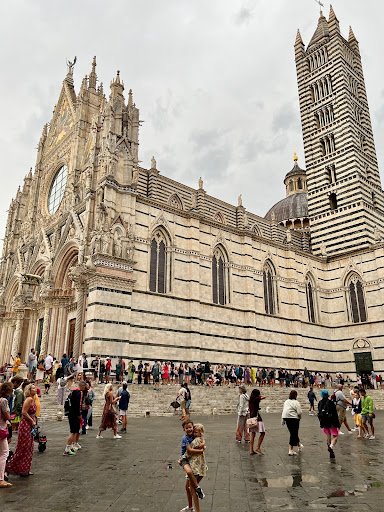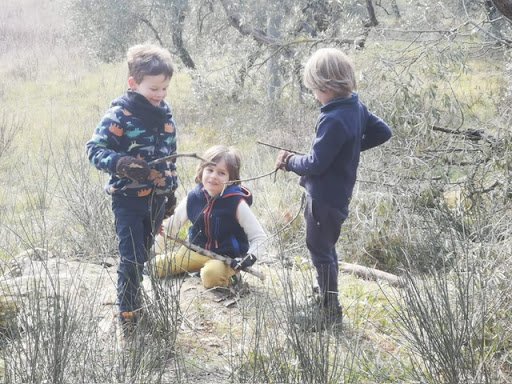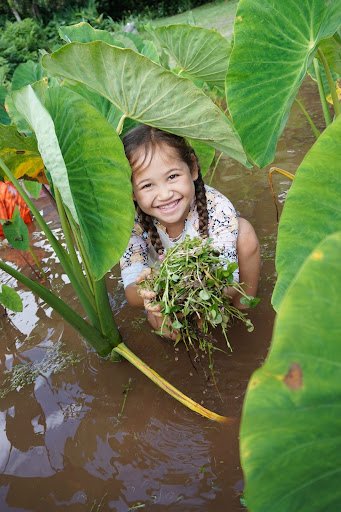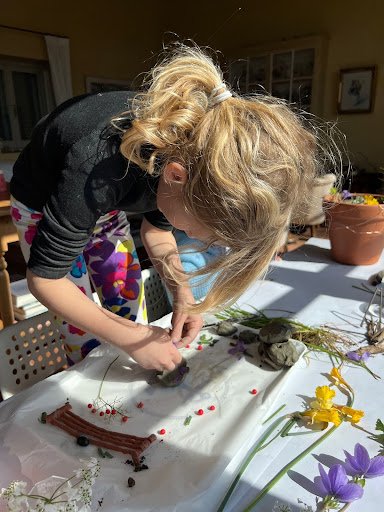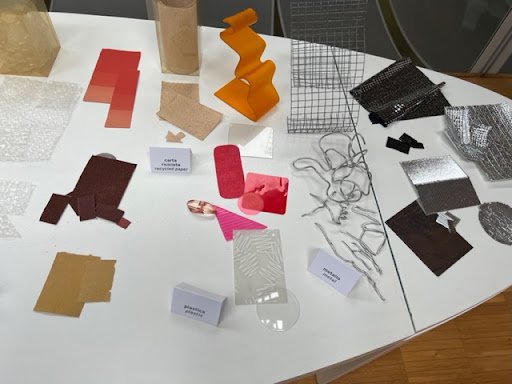By Sarah DeLuca
As we have chosen to work with children, we can say that they are the best evaluators and the most sensitive judges of the values and usefulness of creativity. This comes about because they have the privilege of not being excessively attached to their own ideas, which they construct and reinvent continuously. They are apt to explore, make discoveries, change their points of view, and fall in love with forms and meanings that transform themselves
- Loris Malaguzzi (1993, p 51).
While on sabbatical, I have been thinking a lot about creativity and how it is valued within the Reggio Emilia schools. This concentrated focus has increased my awareness of the power of creativity as it intersects with learning, and now I see it everywhere. For example, my five-year-old son, Enzo, has a range of sticks that are personal artifacts of his day spent in the forest. Each stick has a name and purpose, along with rocks he has been bringing home to hammer and chisel, no doubt inspired by all the sculptures he regularly sees around in public. He reminds me that as Malaguzzi suggests, children have incredibly creative ways of thinking about and using materials. This creativity extends to how they wonder about the world, and there is a special freedom in the ideas of children. We must stop and pause to notice how this creative thinking lends itself to childrens’ hypotheses about how things work and connections throughout our world.
The Duomo Cathedral in Siena
Another example I keep thinking about is a visit I made to the Duomo di Siena (Siena Cathedral), one of my favorite churches with its beautiful gothic architecture, and bold black and white stripes, almost zebra-like. This feature is one children generally love about this church. What is incredibly striking is seeing the duomo (dome) from inside the church, midnight blue with gold stars that seem to mimic the night sky. When we visited, Enzo laid down on the floor directly underneath the dome and stared at the ceiling, asking, “Why is it so big?” I have to admit my first instinct was to be like, “Hey! Enzo! That’s so dirty, stand up!” I understand that this is not the proper protocol in a church, however, I realized and told myself, “this is truly the best way to see the art, in fact, we should all be taking this approach!” I realized he had the most creative idea and his view from the floor was better and more encompassing than any other. So I let him stay and enjoy it until a security guard came and asked him to stand up. He did the same thing in a recent Reggio Emilia workshop, taking photographs of the ceiling as part of a task of photographing architectural features of the International Center, and this time he was not scolded nor asked to stand-up, but, rather, the Reggio educator pointed out his creative viewpoint. That got me wondering how we could have taken it a step further and all laid down to get a different view, a different perspective of the world from below.
Endless creative fun with sticks
Loris Malaguzzi tells us “creativity becomes more visible when adults try to be more attentive to the cognitive processes of children than to the results they achieve in various fields of doing and understanding” (1993, p. 52). We often speak about valuing the process over the product, yet Malaguzzi encourages a deeper reflection into learning by being present and really observing the cognitive processes unfolding for children. He suggests we should do so without an expectation of some predetermined learning or standard created by an adult. What happens when we just watch things unfold naturally for children, and when is that enough? Instead of only noticing a child’s finished product of a painting, or creation, maybe we can start to look at their thinking in action and value the creativity for what it is, listening more acutely and being more present.
The extensive documentation practiced by Reggio Emilia educators is one strategy for enhancing the value and respect of children’s ideas and hypotheses. It allows children to see themselves and their creative processes in different ways and in real time. The rich and meaningful discussions that take place among educators while reviewing documentation–transcripts of children’s conversations, photos and videos of them working together, children’s work and creations–are such an integral part of this approach. They more wholly reflect the importance of dialogue, diverse perspectives, and the value of us all living in relationship with one another. At the Loris Malaguzzi International Center, in large white letters against a yellow painted wall, are ideas the Reggio Emilia educators value, written in different languages. One of my favorite quotes is, “freedom means we discuss.” Carlina Rinaldi sums it up well:
Creativity is not just the quality of thinking of each individual but is also an interactive, relational, and social project. It requires a context that allows it to exist, to be expressed, to become visible. In schools, creativity should have the opportunity to be expressed in every place and in every moment” (2015, p. 46).
Describing the Aesthetic Dimension of Creativity
Beauty and aesthetics all around us
One of the most well-known Atelieristas out of Reggio Emilia, Vea Vecchi, describes the aesthetic dimension of creativity within her book, Art and Creativity in Reggio Emilia. She shares that “an acceptance of aesthetics [is] one of the most important dimensions in the life of our species and, therefore, also in education and in learning” (2010, p. 5). I used to think of the concept of aesthetics as beautifully designed or curated spaces, places in nature that inspired me–something about them being special–but a feeling I couldn’t quite put my finger on. I’m learning now there is SO much more to this word and concept, and if I pay careful attention to aesthetics, it has the potential to add pleasure and joy to both the teaching and learning experiences I create.
To expand on the critical role of aesthetics in education, Vea Vecchi so beautifully and poignantly states:
It is a process of empathy relating the Self to things and things to each other. It is like a slim thread or aspiration to quality that makes us choose one word over another, the same for a color or shade, a certain piece of music, a mathematical formula or the taste of a food. It is an attitude of care and attention for the things we do, a desire for meaning; it is curiosity and wonder; it's the opposite of indifference and carelessness, of conformity, of absence of participation and feeling. (2010, p. 5)
Lilian, a Hanahau‘oli student, immersed in an aesthetic experience
I think of the way the afternoon sun creates illuminations on the wall, the way my daughter’s giggle invokes sheer joy within me, the smell of oatmeal chocolate chip cookies and how it immediately brings me back to my grandmother’s cottage kitchen, the refreshing sensation of jumping into the ocean, a particularly emotional call with my best friend; for me these all invoke an aesthetic experience, “a process of empathy… a desire for meaning.”
In his book Art as Experience, John Dewey describes an aesthetic experience as, “an experience [that] has a unity that gives it its name, that meal, that storm, that rupture of friendship. . . The existence is constituted by a single quality that pervades the entire experience in spite of the variation of its constituent parts” (1934, p. 37). Dewey and Vecchi both talk about a “single quality,” the thing that I can’t always put my finger on but deep down know the significance of. A classmate in my recent graduate class described it as “the way it touches you inside your heart” and the Atelierista at my recent workshop related, “to discover and rediscover beauty.” Think about an experience you’ve had that stands out to you more than other everyday experiences. An experience that makes you reflect back and say, “wow, that truly was a beautiful experience.” What was the aesthetic quality of that experience? What are the ways we become sensitive and attuned to these qualities? Why are aesthetic qualities so strongly connected to learning in Reggio Emilia?
Aesthetics as Activator for Learning
A state of “relaxed alertness”
As the Reggio educators describe, the aesthetic dimension of living and teaching is grounded in empathy and creating relationships in all forms–between people, children, objects, materials, environments and places. They also go further to detail how aesthetics play such an important role in cognitive processes in general. Expanded on by Vecchi, “If aesthetics fosters sensibility and the ability for connecting things far removed from each other, and if learning takes place through new connections between disparate elements, then aesthetics can be considered an important activator for learning” (2010. p. 9). I see this in my own classroom and with children–when they are stimulated and engaged with materials, with their natural world, and with each other, they are in a sweet spot of learning that authors Renata and Geoffrey Caine call “relaxed alertness” (2011, p. 8). This connects directly to Malaguzzi’s quote about separating “the head from the body” in the 100 Languages of Children poem; cognition is activated and deepened through hands-on experiences. Vecchi describes this more elaborately, “rationality without feeling and empathy, like imagination without cognition and rationality, builds up partial, incomplete human knowledge” (2010, p. 6).
Aesthetics, I’ve learned over the course of my sabbatical, informs so much, including the importance of relationships, of materials with each other, with the environment, and with the learners. It is a way of being and of learning, and encourages us to embrace the wonder and curiosity of the world. The intentionality of using your senses to explore, be human, slow down and be present is what defines the aesthetic dimension for me. This is truly what children teach us each day by being themselves. When you feel present and connected, you feel those relationships. It also brings me back to the image of the child and the fact that children have a right to these experiences–children have a right to this emotional, beautiful, stimulating, optimal environment for learning. One of the beliefs about learning at our school, Hanahau`oli, is that learning should be “exciting, challenging, and enjoyable.” An intentional, aesthetically pleasing environment supports this belief.
Sensory Qualities in an Environment
The “Atelier of tastes” in Reggio Emilia
Charles Schwall, contributing author of In the Spirit of the Studio, describes the importance of sensory knowledge. He says it holds “the potential to inform the development of a language: materials can be charged with meaning when the hands and the mind work together” (2015, p. 57). Visiting the Reggio Emilia classrooms is a sensory-rich experience, and it is clear this sensory stimulation is an intentional focus for activating learning. Architect Michele Zini builds on the importance of sensory experiences in the learning environment:
The search to give a multisensory dimension to the environment, which means working on identifying the materials, the lights, the colors, (the so-called soft qualities), with the aim of providing not just comfort, functionality and easy maintenance, but also a sensory richness that is empathic with the children’s cognitive processes. If children are a sensory laboratory and they know and interpret the world by engaging all five senses, then they deserve an environment that is rich from a sensory point of view with a design that enhances these aspects.” (2010, p. 100).
Recently I participated in a workshop in Reggio Emilia with other Italian educators. It was focused on working in the atelier. This atelier was called “Sensitive Forms.” What I learned throughout the process was that observing and using our senses very closely to describe objects, helps us discover relationships and meaning among them.
Materials arranged for an atelier experience
Here is one example of an exercise we did together. On a white table, beautifully arranged, was a wide variety of natural materials (leaves, dried flowers, rough looking pieces of wood, dried fruit, living plants, rocks, and more) and on another table lay artificial materials, arranged by color (sponges, paper, various glass and plastic shapes, wire and mesh, various types of fabric, bubble wrap, cellophane, and more). We worked in groups to describe, in detail, an object from each table while educators encouraged us to go deeper and asked, “What is observation? How do children observe? How can you make your eyes more attentive? What relationships are possible between the materials?” We shared what we observed with the larger group, and then, only after first observing with our bodies and senses, used digital microscopes, magnifying glasses, and small spot lights to observe minute details. We were then invited to explore the vast amount of graphic materials and to draw our observations. This entire experience was slow and intentional. It involved careful observations, dialogue, reflection, experimenting with materials and the chance to go deeper. I really appreciated the opportunity and time for making meaning and connections through the materials, particularly while engaging my senses.
Zini describes the importance of creating this type of relationship between the environment and our interactions with it:
Research in neuroscience and social science confirms that our identity develops from our experiences of the environment as well as our genetic history. We develop our senses and cognitive abilities through interaction with our environment. Children are a laboratory for the senses with each sense activating other senses . . . As a result, the child’s environment cannot be seen just as a context for learning or a passive setting for activities; it is an integral part of learning and helps define their identity (Zini, 2005, p. 2).
A multisensory experience in Reggio Emilia
This explains why engaging the senses is such an important part of the approach, and why the Reggio educators go into great detail about each sense and the potential for engagement and learning. For example, Michele Zini elaborates on the sense of smell and the idea of an “aromoscape” by sharing the insight that "the olfactory sense communicates with the most 'ancient' part of the brain . . . it can immediately reawaken the image and memory of a place" (p. 84). I started to think, what might an “aromacape” look like in my teaching and learning environment? What feelings, thoughts, memories do smells invoke and how does this ultimately shape our experience? I remembered that in each Reggio Emilia preschool and infant toddler center, there is a kitchen and dedicated cooking staff. They cook delicious whole food snacks and meals for children each day. This has been something the city has had to advocate to maintain, as they believe the language of taste and food is incredibly important. At times children help to cook meals, set the table at meal times, design place settings to create beautiful and pleasurable places to eat, and grow food. They explore the many beautiful colors, tastes, textures, and aromas of the food they eat and the culture it represents. How might I recreate some of this when I return to Hanahauʻoli School?
Creating our own tea in Reggio Emilia
When my children went to Reggio Emilia for a family Sunday there was an entire table of different dried herbs, flowers, and fruits for children to smell. They used tiny wooden tongs to pick out their favorite smells to combine into a tea. A cool spring day, they delighted in their warm, homemade tea, and the flavors and scents it brought forth for them, no doubt invoking pleasure and memory. They were then invited to draw and write down what they used in their tea and give it a name. My daughter Sicilia named her tea “Ivy’s Tea” inspired after her Ivy and Bean books, and asked if she could make another bag to take home. Enzo, who is currently reluctant to draw and write, surprised us all by picking up colored pencils and happily drew about dinosaurs, trucks, and trees and proceeded to tell me a story all about it. Perhaps he was inspired, as I was, by the visit to Reggio Emilia; Perhaps the beautiful environment of the international center and his experiences creating, engaging his senses, and delving into multiple languages helped him to relax and enjoy drawing in a new way.
As I watched my children engage in these aesthetic and sensory rich experiences, I thought of Margie Cooper’s words in her chapter Is Beauty a Way of Knowing?:
Often, Reggio educators use the phrase rich normality to describe the physical, social, emotional, and cognitive environments to which they continually aspire, calling important attention to the promise of ordinary moments. For it is the stringing together of ordinary moments that ultimately gives shape and quality to human life over time, just as it is the stringing together of ordinary moments that ultimately gives shape and quality to infant-toddler centers and preschools (2012, p. 289-99).
When we left the center that day, I thought about the last moment in the workshop I attended. One of the teachers I worked alongside reflected on the day. She was a teacher in Reggio Emilia, but not in the infant and toddler schools. She shared how proud she was of her city for respecting children and allowing them this time to wonder and delight in childhood. Earlier in the day we were talking and she asked me all about Hawaiʻi, what I was doing in Italy, and asked if there was a Hawaiian word to describe the lava-like, soft folds in the dried pear we were observing. I shared about pahoehoe lava in my group. She had so simply helped to encourage a connection between my identity and context, and the materials I was observing. As she reflected and described her experiences in the workshop, the emotion in her voice was palpable and her last statement had several of us in tears. She said, “When you’re standing in front of a child, you're standing in front of the future of humanity.” I thanked her later for what she shared and she told me, “I believe in what I said.” I told her, “I believe in what you said too.” I realized later that our conversations, both during and after the workshop, and listening to her speak about children, was an aesthetic experience for me. It involved empathy, relation, quality, meaning. So far from home, it allowed me to share a bit of who I am and where I come from. It incited an emotional reaction to how I feel deeply about children and this work.
When I started to write the blog entries in this three-part series on the environment as the third educator, I was completely overwhelmed. The idea of synthesizing the vast, complex, rich, and beautiful way the Reggio Emilia educators view beauty, aesthetics, and the environment as true activators for learning, and as a right for children, is difficult. It’s challenging because of the constantly progressing group of learners, and the self-reflection required of the educator, continuously evolving alongside them. As humans we are naturally drawn to beautiful spaces–a hike in a dense green forest, exploring coral in crystal-clear, warm waters, a cafe filled with natural light, greenery, and incredible scents. I feel I am seeking and more consistently noticing the beauty that surrounds us everyday and am finding the inspiration taken from these places to bring the intentionality of aesthetics into learning spaces. Children deserve to be immersed in an environment that encourages meaning-making, incites wonder and creativity, and allows opportunities to discover the relationships within these places. If we take the time to notice these connections, provide time and materials for children to express themselves through the “100 languages,” and design our spaces to engage the senses, then we can further activate learning and knowledge-building in more dynamic ways for children, and all learners.
Works Cited:
Cadwell, Louise. (1997) Bringing Reggio Emilia Home: An Innovative Approach to Early Childhood Education. New York, N.Y.: Teachers College Press.
Caine, R., & Caine, G. (2011). Natural Learning for a Connected World: Education, Technology, and the Human Brain.
Cooper, M. (1993) Is Beauty a Way of Knowing?. Gandini, Lella, Edwards, Carolyn P. and Forman, George. The Hundred Languages of Children: the Reggio Emilia Experience in Transformation. Norwood, N.J. :Ablex Pub. Corp.
Dewey, J. (1934). Art as Experience. New York: Perigee Books.
Malaguzzi, L. (1993) History, Ideas, and Basic Principles. Gandini, Lella, Edwards, Carolyn P. and Forman, George. The Hundred Languages of Children: the Reggio Emilia Experience in Transformation. Norwood, N.J.: Ablex Pub. Corp.
Rinaldi, C. (2015) The Whole School as an Atelier: Reflections by Carlina Rinaldi. In L. Gandini, L. Hill, L. Cadwell, & C. Schwall (Eds.), In the Spirit of the Studio: Learning from the Atelier of Reggio Emilia. New York, N.Y: Teachers College Press.
Schwall, C. (2015) The Grammar of Materials. In L. Gandini, L. Hill, L. Cadwell, & C. Schwall (Eds.), In the Spirit of the Studio: Learning from the Atelier of Reggio Emilia. New York, N.Y: Teachers College Press.
Vecchi, Vea. (2010) Art and Creativity in Reggio Emilia: Exploring the Role and Potential of Ateliers in Early Childhood Education. London, England and New York, N.Y.: Routledge.
Zini, M and Ceppi, G.. (1998) Children, Spaces, Relations: Metaproject For an Environment for Young Children. Reggio Emilia, Italy: Reggio Children.
ABOUT THE AUTHOR:
Sarah DeLuca is a K-1 early childhood educator at Hanahauʻoli School, where she has been teaching and learning with and from her students, colleagues, and families since 2009. Sarah was born and raised in the Kaimuki area and is an alumnus of Iolani School. She received her bachelor's degree from the University of Oregon in International Studies and her (MEdT) at the University of Hawaii at Manoa. She has lived and studied in Italy and enjoys traveling to spend time with extended family there. She finds great joy in working alongside young children, particularly exploring our beautiful island home, creating art, and getting lost in the wonderful world of books.

